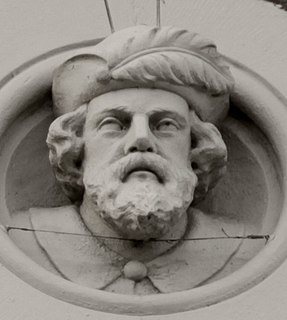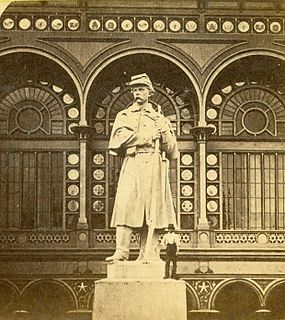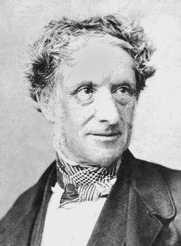 W
WJohn Wormald Appleyard was a sculptor and monumental mason based in Leeds, West Yorkshire, England. He was sixteen years old when his apprenticeship as a stone carver was curtailed due to the death of his grandfather who was training him. He was versatile enough to turn his hand to wood carving, decorative ceiling work, stained glass and marble sculpture besides stone carving, so that from around the age of twenty-one years he was able to maintain a stoneyard and studio in Cookridge Street, Leeds, at least until 1891. He was generally known during his lifetime as a monumental mason. He is mainly known today in Leeds for his wooden Jacquemart figures of Robin Hood, Friar Tuck, Richard the Lionheart and the swineherd Gurth, which strike the hours on the Ivanhoe clock at one end of Thornton's Arcade in Briggate. He is also known for his figure of Old Father Time on the Tempus Fugit clock on the Time Ball Buildings, Leeds.
 W
WJames Goodwin Batterson was an American designer and builder, the owner of New England Granite Works from 1845 and a founder in 1863 of Travelers Insurance Company, both in Hartford, Connecticut. He introduced casualty insurance in the United States, for which he was posthumously inducted into the Insurance Hall of Fame (1965).
 W
WCarlo Giuseppe Bergamin was a sculptor and monumental mason born in Carrara, in Italy, who later migrated to New Zealand. He is known there as the designer of a number of well-regarded war memorials, in New Zealand, relating to the Boer War.
 W
WSolon Hannibal de la Mothe Borglum was an American sculptor. He is most noted for his depiction of frontier life, and especially his experience with cowboys and native Americans.
 W
WJames George Bubb (1781-1853) was a prolific sculptor in marble and artificial stone of the early Victorian era who is now largely forgotten. His sculptures adorn buildings across the United Kingdom while his relief adorning the Italian Opera House in London was the largest undertaken in Great Britain at that time.
 W
WCarl H. Conrads was an American sculptor best known for his work on Civil War monuments and his two works in the National Statuary Hall Collection at the U.S. Capitol in Washington, D.C. He was also known as Charles Conrads.
 W
WJørgen Christian Dreyer was a Norwegian-born American sculptor. He emigrated to the United States in 1903 and worked as a professor of sculpture at the Kansas City Art Institute from 1907 to 1909. In his career Dreyer created a number of monumental sculptures, some of which are located in Kansas City, Missouri. His major works include: Life Drift; The Goddess of Dawn; Sphinxes (pair); Biology and Chemistry ; Lionesses (pair); The Message ; Bust of Sir Carl Busch; Mercury, god of commerce; and Bust of Major General Sterling Price.
 W
WJohn Hemenway Duncan was an American architect.
 W
WThomas Earp (1828–1893) was a British sculptor and architectural carver who was active in the late 19th century. His best known work is his 1863 reproduction of the Eleanor Cross which stands at Charing Cross in London. He specialised in sculpture for Gothic Revival churches and worked closely with the architect George Edmund Street in the 1860s and 1870s.
 W
WJoseph Edwards was a Welsh sculptor. His work appears in many churches and cemeteries in England and Wales, in Westminster Abbey, and in the old town hall of Merthyr Tydfil. Seventy of his works were exhibited at the Royal Academy of Arts between 1838 and 1878.
 W
WJohn Frazee was an American sculptor and architect. The Smithsonian has a collection of many of his sculptures as well as paintings of Frazee by other artists including Asher B. Durand and Henry Colton Shumway
 W
WArthur Eric Rowton Gill was an English sculptor, typeface designer, and printmaker, who was associated with the Arts and Crafts movement. His religious views and subject matter contrast with his sexual behaviour, including his erotic art, and his extramarital affairs and sexual abuse of his daughters, sisters, and dog.
 W
WThe Glasgow Necropolis is a Victorian cemetery in Glasgow, Scotland. It is on a low but very prominent hill to the east of Glasgow Cathedral. Fifty thousand individuals have been buried here. Typical for the period, only a small percentage are named on monuments and not every grave has a stone. Approximately 3,500 monuments exist here.
 W
WA headstone, tombstone, or gravestone is a stele or marker, usually stone, that is placed over a grave. It is traditional for burials in the Christian, Jewish, and Muslim religions, among others. In most cases, it has the deceased's name, date of birth, and date of death inscribed on it, along with a personal message, or prayer, but may contain pieces of funerary art, especially details in stone relief. In many parts of Europe, insetting a photograph of the deceased in a frame is very common.
 W
WHilary Byfield Stratton FRBS was an English sculptor, stonemason and teacher working in the 20th Century. He is best known for his stone carvings and memorials but experimented in other media that included: perspex, copper and resin. Stratton was an adherent of Eric Gill, with whom he was apprenticed at the age of thirteen, whilst the influence of the Arts and Crafts movement was evident in much of Stratton's work.
 W
WLetter cutting is a form of inscriptional architectural lettering closely related to monumental masonry and stone carving, often practiced by artists, sculptors, and typeface designers. Rather than traditional stone carving, where images and symbols are the dominant features, in letter cutting it is the beauty of the stone carver's calligraphy that is the focus. Notable practitioners include:Eric Gill Ralph Beyer David Kindersley Richard Kindersley John Shaw Macdonald Gill
 W
WThis is a list of monumental masons, also known as memorial masons:
 W
WElsie March was an English sculptor and one of eight artists in her family. After the death of her brother Vernon March, she and her brothers completed the National War Memorial of Canada in Ottawa, Ontario. One of the family's three sculptors, her focus earlier in her career was metalwork and painting.
 W
WSydney March (1876–1968) was an English sculptor. His primary focus was portrait busts and other sculptures of British royalty and contemporary figures, as well as war memorials. The second-born of eight artists in his family, he and his siblings completed the National War Memorial of Canada after the death of their brother Vernon March in 1930, who had created the winning design. It is the site in Ottawa of annual Remembrance Day ceremonies.
 W
WVernon March (1891–1930) was an English sculptor, renowned for major monuments such as the National War Memorial of Canada in Ottawa, Ontario, the Samuel de Champlain Monument in Orillia, Ontario, and the Cape Town Cenotaph, South Africa. Without the benefit of a formal education in the arts, he was the youngest exhibitor at The Exhibition of the Royal Academy of Arts.
 W
WGeorge F. Meacham was an architect in the Boston, Massachusetts, area in the 19th century. He is notable for designing Boston's Public Garden, the Massachusetts Bicycle Club, and churches, homes, and monuments in greater Boston and elsewhere in New England.
 W
WMonumental masonry is a kind of stonemasonry focused on the creation, installation and repairs of headstones and other memorials.
 W
WJohn Francis Moore was a sculptor who was active in late 18th century Britain. His works include two memorials in Westminster Abbey.
 W
WJohn G. Mossman was one of a number of English sculptors who dominated the production and teaching of sculpture in Glasgow for 50 years after his arrival with his father and brothers from his native London in 1828. His father William Mossman (1793–1851) was also a sculptor, and a pupil of Sir Francis Chantrey. He was trained both by his father and under Carlo Marochetti in London.
 W
WReeves was the most prominent firm of monumental masons in Bath, Somerset. They flourished from c. 1778 to the 1860s. They often signed their work with "Reeves," or occasionally "Reeves & Son of Bath" when commissioned outside of Bath. One memorial is in the Grade I-listed City of London church St. Magnus the Martyr.
 W
WFrank Rusconi was, together with his brother, Joseph, quarry owner and monumental mason of Gundagai, New South Wales, Australia.
 W
WStone carving is an activity where pieces of rough natural stone are shaped by the controlled removal of stone. Owing to the permanence of the material, stone work has survived which was created during our prehistory.
 W
WPeter Turnerelli (c.1772–1839) was an Irish-born sculptor of Italian descent working in Britain in the early 19th century.
 W
WWilliam Robertson Warren was a Newfoundland lawyer, politician and judge who served as the dominion's Prime Minister from July 1923 to April 1924.
 W
WHenry Weekes was an English sculptor, best known for his portraiture. He was among the most successful British sculptors of the mid-Victorian period.
 W
WRichard Westmacott RA – also sometimes described as Richard Westmacott III – was a prominent English sculptor of the early and mid-19th century.
 W
WSir Richard Westmacott was a British sculptor.
 W
WOnslow Ernest Whiting was an English sculptor and teacher.